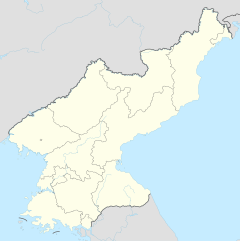Human experimentation is an issue raised by some North Korean defectors and former prisoners. They have described suffocation of prisoners in gas chambers, testing deadly chemical weapons and surgery without anesthesia.
Hoeryong concentration camp was a death camp in North Korea that was reported to have been closed in 2012. The official name was KwallisoNo. 22. The camp was a maximum security area, completely isolated from the outside world.
The human rights record of North Korea is widely considered to be among the worst in the world and has been globally condemned, with the United Nations and groups such as Human Rights Watch all critical of it. Amnesty International considers North Korea to have no contemporary parallel with respect to violations of liberty.
Yodok concentration camp was a kwalliso in North Korea. The official name was Kwan-li-so No. 15. The camp was used to segregate those seen as enemies of the state, punish them for political misdemeanors, and put them to hard labour. It was closed down in 2014.
Lee Soon-ok is a North Korean defector and the author of Eyes of the Tailless Animals: Prison Memoirs of a North Korean Woman, her account of being falsely accused, tortured, and imprisoned under poor conditions for crimes against the state and her subsequent release from prison and defection from the country. Since leaving North Korea, she has resided in South Korea.

The Committee for Human Rights in North Korea (HRNK), formerly known as the U.S. Committee for Human Rights in North Korea, is a Washington, D.C.-based non-governmental research organization that "seeks to raise awareness about conditions in North Korea and to publish research that focuses the world's attention on human rights abuses in that country."
The Onsong concentration camp was an internment camp in Changpyong, Onsong County, North Hamgyong, North Korea. It housed approximately 15,000 political prisoners. The camp was officially known as Concentration Camp (Kwan-li-so) No. 12.
Kaechon concentration camp is a prison in North Korea with many political prisoners. The official name is Kyo-hwa-so No. 1. It is not to be confused with Kaechon internment camp, which is located 20 km (12 mi) to the south-east.

Kangdong County, is one of Pyongyang's two suburban counties. In 1983 it was separated from South P'yongan Province and assumed direct governance by the Pyongyang City People's Committee. It is bordered by Sŏngch'ŏn-gun, South P'yongan in the north and east, Sŭngho-guyŏk from the south and the Taedong River from the west.
Kaechon Internment Camp is a labor camp in North Korea for political prisoners and descendants of alleged criminals. The official name for the camp is Kwan-li-so No. 14. The camp is commonly known as Camp 14. It is not to be confused with the Kaechon concentration camp, which is located 20 km (12 mi) to the northwest. Nearest train station is the Oedong station of the Taegon Line.
Pukch'ang concentration camp is a labor camp in North Korea for political prisoners. It is sometimes called Tŭkchang concentration camp. The official name is Kwan-li-so No. 18.
Hwasong concentration camp is a labor camp in North Korea for political prisoners. The official name is Kwan-li-so No. 16.

Shin Dong-hyuk is a North Korean-born human rights activist. He claims to be the only prisoner to have successfully escaped from a "total-control zone" grade internment camp in North Korea. His biography, Escape from Camp 14: One Man's Remarkable Odyssey From North Korea to Freedom in the West, was written with the assistance of former Washington Post journalist Blaine Harden.
Chongjin concentration camp is a labour camp in North Korea for political prisoners. The official name is Kwan-li-so No. 25. Satellite images show a major expansion of the camp after 2010.
Chongori concentration camp is a reeducation camp in North Korea. The official name of the camp is Kyo-hwa-so No. 12.
Prisons in North Korea have conditions that are unsanitary, life-threatening and are comparable to historical concentration camps. A significant number of inmates have died each year, since they are subject to torture and inhumane treatment. Public and secret executions of inmates, even children, especially in cases of attempted escape, are commonplace. Infanticides also often occur. The mortality rate is exceptionally high, because many prisoners die of starvation, illnesses, work accidents, or torture.
Kwalliso (Korean: 관리소) or kwan-li-so is the term for political penal labor and rehabilitation colonies in North Korea. They constitute one of three forms of political imprisonment in the country, the other two being what Washington DC based NGO Committee for Human Rights in North Korea described as "short-term detention/forced-labor centers" and "long-term prison labor camps", for misdemeanor and felony offenses respectively.
Kangdong concentration camp is a reeducation camp in North Korea. The official name of the camp is Kyo-hwa-so No. 4.
Kyo-hwa-so Hoeryong(회령교화소) is a "reeducation camp" in Hoeryong, in North Hamgyong province of North Korea. It is not to be confused with Haengyong political prison camp, which is located 10 km (6.2 mi) north-east of Hoeryong and is sometimes also called Hoeryong camp. It holds roughly 1,500 prisoners.
Hamhung concentration camp is a reeducation camp in North Korea. The official name of the camp is Kyo-hwa-so No. 9. The sub-facility for women is sometimes called Kyo-hwa-so No. 15.



